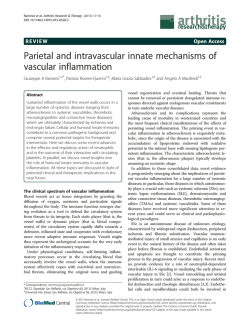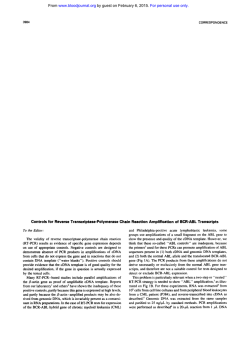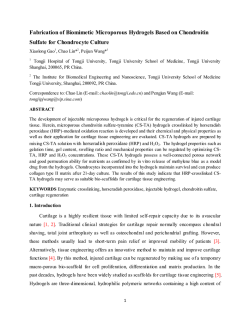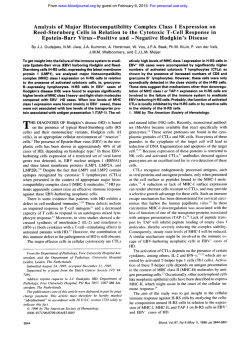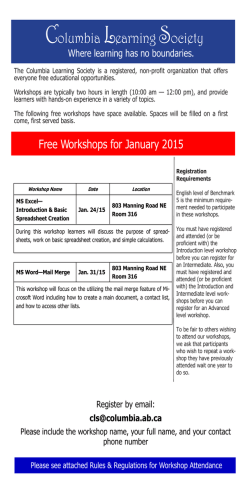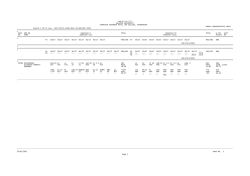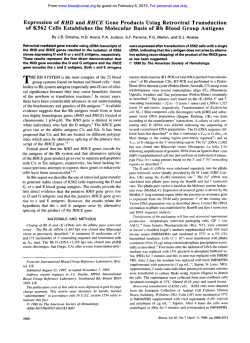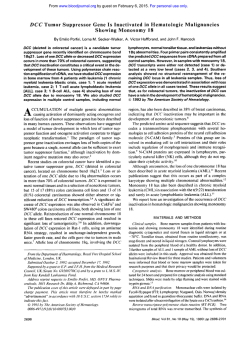
Synthesis of classical pathway complement
Immunology 1996 88 648-656 Synthesis of classical pathway complement components by chondrocytes K. BRADLEY, J. NORTH, D. SAUNDERS, W. SCHWAEBLE, M. JEZIORSKA,* D. E. WOOLLEY* & K. WHALEY Department of Microbiology and Immunology, University of Leicester, Leicester, and *Department of Medicine, Manchester Royal Infirmary, Manchester SUMMARY Using immunohistochemical studies, Clq, Cls, C4 and C2 were detected in chondrocytes in normal human articular cartilage and macroscopically normal articular cartilage from the inferior surfaces of hip joints of patients with osteoarthritis. Using reverse-transcribed polymerase chain reaction (RT-PCR), mRNA for Clq, Cls, C4 and C2 was also detected in RNA extracted from articular cartilage. Clr, C3, Cl-inhibitor, C4-binding protein and factor I were not detected by either technique. Articular chondrocytes cultured in vitro synthesized Clr, Cls, C4, C2, C3 and Cl-inhibitor but not Clq, C4-binding protein or factor I, as assessed by enzyme-linked immunosorbent assay (ELISA) and Northern blot analysis. Thus cultured articular chondrocytes have a complement profile that is similar to that of cultured human fibroblasts rather than that of articular chondrocytes in vivo. Complement synthesis in cultured chondrocytes was modulated by the cytokines interleukin-l# (IL-If,), tumour necrosis factor-a (TNF-a) and interferon-y (IFN-y), showing that cytokines can probably regulate complement synthesis in intact cartilage. The possible roles of local synthesis of complement components by chondrocytes in matrix turnover and the regulation chondrocyte function are discussed. During classical pathway activation a number of important pro-inflammatory products are generated, including anaphylatoxins C4a, C3a and C5a which are cleaved from the N-termini of C4, C3 and C5, respectively. These peptides activate different cell types including neutrophils, macrophages and mast cells, and C5a is a powerful chemotaxin.4 C3b and iC3b ligate the complement receptor CR1 and CR3, respectively, and ligation of CR3 results in phagocytosis.5 Although the C5b-9 membrane attack complex (MAC) is able to lyse cells, at sublytic concentrations it will activate a variety of nucleated cells including neutrophils, macrophages and synoviocytes. This results in secretion of cytokines, arachadonic acid metabolites and reactive oxygen species.6 Although the liver is the major site of synthesis for most circulating complement components, Clq, properdin and factor D do not appear to be synthesized by hepatocytes in vivo.7 Clq is synthesized by follicular dendritic cells, interdigitating cells and cells of the monocyte-macrophage lineage;8 factor D is synthesized mainly by adipocytes and mononuclear phagocytes,9"10 while properdin is synthesized by mononuclear phagocytes and T lymphocytes.' 0 1 Apart from these, many of the other components can also be synthesized in extra hepatic tissues. It appears that C3 and factor B are made by most cell types, while mononuclear phagocytes, endothelial cells and fibroblasts in culture are able to synthesize a range of complement components.7 There is good evidence that both normal and inflamed synovial membrane can synthesize all the components of the classical pathway.'2"13 It is thought that such local synthesis of complement components may be INTRODUCTION The complement system comprises a group of proteins that promote the inflammatory response and destroy micro-organisms. The classical pathway comprises Cl, C4 and C2. The C1 macromolecular complex (Clq: Clr2: Cls2) is a product offive genes; three encode the A, B and C chains of Clq,I while CIr and CIs are each encoded by a single gene.2 The classical pathway is usually activated when C1 binds to antibody complexes containing IgM or IgG antibody.3 Activated Cl then actives C4 and C2 by a limited proteolysis. Activated C4 (C4b) binds covalently to suitable target surfaces. C2, the ratelimiting component of the classical pathway, binds to C4 prior to activation by Cl. Once activated by limited proteolysis the classical pathway C3 convertase (C4b2a) is formed. The convertase cleaves C3 into C3a (anaphylotoxin) and C3b. The C3b binds covalently to acceptor groups, and that which binds to the C4b component of C4b2a converts its specificity from C3 convertase to the C5 convertase, C4b2a3b.3 Fluidphase regulatory proteins that modulate classical pathway activation include Cl-inhibitor (Cl-inh), which prevents spontaneous activation of Cl and inhibits activated C14 and C4-binding protein (C4-bp), which acts as a cofactor for factor I (I) in the degradation of C4b.3 Received 19 October 1995; revised 5 March 1996; accepted 16 April 1996. Correspondence: Professor K. Whaley, Department of Microbiology and Immunology, University of Leicester, University Road, Leicester LEI 9HN, UK. 648 68 1996 Blackwell Science Ltd 649 Synthesis of complement components by chondrocytes important in host defence in the tissues and may also contribute to the inflammatory process. In this paper we report that chondrocytes in articular cartilage synthesize the classical pathway complement components Clq, Cls, C4 and C2, but do not synthesize to Clr, C3, Cl-inh, C4-bp or factor I. We also show that the chondrocytes in culture in vitro lose the ability to synthesize the Clq but begin to synthesize C3 and Cl-inh in addition to C I r, C I s, C4 and C2, a phenotype which is the same as fibroblasts. MATERIALS AND METHODS Immunohistochemistry Macroscopically normal, full-thickness articular cartilage was obtained from the inferior surfaces of hip joints of four patients undergoing joint replacement surgery for osteoarthritis, and from two normal knee joints following amputation. Rheumatoid synovial tissue was obtained from remedial synovectomies and used as positive controls to check complement component staining with each of the primary antibodies. Cartilage specimens were fixed in Carnoy's solution (4 hr), washed in 90% alcohol and routinely processed to paraffin wax. Tissue sections (4 mm) were cut, dewaxed, rehydrated and examined for the presence of complement components using the following antibodies: goat anti-human Clr and Cls (Atlantic Antibodies, High Wycombe, UK); rabbit anti-human Clq, C3, C4 and Clinh (Dako Ltd, High Wycombe, UK); and sheep anti-human C2, factor I and C4-bp (The Binding Site, Birmingham, UK). Tissue sections of rheumatoid synovium were prepared and treated in the same way. Immunohistochemical techniques The technique used was that described by Jeziorska et al.,'4 the main details of which are given below. For all antibody treatments, tissue sections were first pretreated with normal serum from the same species as the secondary antibody, diluted 1:10 with Tris-buffered saline (TBS). Primary polyclonal antibodies, suitably diluted, were applied to tissue sections for 2 hr at 200. After three 10-min washes in TBS, biotinylated secondary antibodies were applied for 45 min, followed by further washing in TBS. ABC complex (Dako) conjugated with alkaline phosphatase (AP) was then applied for 45 min, washed in TBS, and developed using New Fuchsin to provide a permanent red stain. No counterstaining Rabbit, goat and sheep antibodies were followed with biotinylated IgG: swine anti-rabbit IgG (diluted 1: 300) and rabbit anti-goat IgG (diluted 1: 400; Dako), and donkey antisheep IgG (diluted 1: 500; The Binding Site). TBS or non-immune IgG (rabbit IgG from Dako and goat and sheep IgG both from Sigma Chemical Co., Poole, UK) in concentrations of IgG similar to those of the relevant primary antibodies were substituted for the primary antibodies on control tissue sections, and consistently produced negative observations. The sections were dehydrated, mounted in XAM Mountant (BDH, Nottingham, UK), examined and photographed using a Zeiss Photomicroscope III and TMAX 100 pro film (Kodak Ltd, Hemel Hempstead, UK). was used. Complement cDNA Plasmids containing cDNAs for Clq A-chain, Clq B-chain, CIr, Cls, C4, C2, C3, C1-inh, C4-bp and factor I were used. Details of the plasmids are given in Table 1. Detection of complement component mRNA in articular cartilage RNA extraction. Macroscopically normal, full-thickness cartilage was obtained from the inferior surfaces of femoral heads of six patients (two male, four female) undergoing joint replacement surgery, and the femoral head of one normal patient (female) with fractured neck of femur. The joint surfaces were washed in ice-cold TBS before cartilage was removed using a scalpel, and snap-frozen in liquid nitrogen. Frozen cartilage fragments were ground into powder under liquid nitrogen using a mortar and pestle. Total RNA was extracted from the frozen powder by the method of Chirgwin et al.,23 and separated by a 4-7 M caesium chloride (Fisons, Loughborough, UK) gradient at 600OOg in a Beckman ultracentrifuge using the SW 41 rotor. The gradient was removed and the pellet dissolved in 200 yil diethylpyrocarbonate (Sigma)-treated water. The RNA was precipitated with ethanol overnight at -20° and pelleted by centrifugation (MSE Microcentauer Microfuge, Sanyo Gallenkamp PLC, Leicester, UK) at 20 000g for 30 min. The pellet was washed with 70% (v/v) ethanol, dried on ice for 30 min, before being dissolved in diethylpyrocarbonate (DEPC)-treated water, quantified by measuring the absorbance at 260 nm, and stored at 700. - Table 1. Details of plasmids containing cDNAs for complement components studied Plasmid CIqA/pBluescript KS+ ClqB/pAT153 Clr/pUC9 C1s/pUC9 C4B/pBluescript KS+ C2/pGEM C3/pBluescript KS+ C1-inh/pBluescript KS+ C4-bp/pBluescript SK+ Factor I/pAT153 Fragment Insert length length (kb) PCR product Reference 1 1 15 16 17 18 19 20 21 22 XbaI/EcoRI BamHI/HindIII Sail/HindIll Sall/HindIII EcoRI/XbaI BamHI/HindIII EcoRI/only EcoRI/HindIII EcoRI/XbaI BamHI/ClaI 1-2 1-2 2-2 2-2 50 0-4 1-8 1-6 2-0 1-6 421 402 524 551 500 400 501 415 413 425 © 1996 Blackwell Science Ltd, Immunology, 88, 648-656 (bp) K. Bradley et al. 650 Table 2. Oligonucleotide primers used for RT-PCR* Annealing temperature usedt Clq A-chain Clq B-chain CIr CIs C4 C2 C3 Cl-inh C4-bp Factor I Actin Forward: Reverse: Forward: Reverse: Forward: Reverse: Forward: Reverse: Forward: Reverse: Forward: Reverse: Forward: Reverse: Forward: Reverse: Forward: Reverse: Forward: Reverse: Forward: Reverse: CAG GAA ACA TCA AGG ACC 3' 5' TCA GGC AGA TGG GAA GAT 3' 450 AAA ATC GCC TTC TCT GCC 3' 5' TCA GGC CTC CAT ATC TGG 3' 5' GAA GAG CTC ATG AAG CTA GG 3' 5' TCA GTC CTC CTC CTC CAT CTC 3' 5' CGA ACC AAT TTT GATAAT GAC 3' 5' TTA GTC CTC ACG GGG GGT GC 3' 5' GCT GAT CTG GGC ATC CAG CTT 3' 5' TGT CAG TGC TCG GGC CGA TCT 3' 5' AGC CAA TCT GGC TCT GCG GAG 3' 5' AGC CCT TTT GCG GGA GTT TTT 3' 5' AGA ACC CCA TGA GGT TCT CGT 3' 5' GTA GTT CCA CCC TCA CCT TGA 3' 5' TCC AAA TGC TAC CAG CTC 3' 5' TCTTCA TTG CTGAGGAGG 3' 5' GAT GGC GAA TGG GTG TAT 3' 5' TTCA CAG GTA GGA GGG 3' 5' GCA AGG TCA CTT ATA CAT CTC 3' 5' GAA ACC CAA GGT CAA GGCAGG 3' 450 5' 5' 430 430 520 480 520 450 460 530 5'GGAGCAATGATCTTGATCTT3' 5'CCTTCCTGGGCATGGAGTCCT3' * PCR conditions: 950, 3 min; 30 cycles of 950, 1 min, X°, 1 m, 720, 7 min; 720, 5 min. t Annealing temperature for actin was the same as for reactions for individual components. Reverse transcription (RT) and polymerase chain (PCR) amplification Complementary DNA (cDNA) was produced from cartilage mRNA by RT using 1-2 pl total RNA and the SuperscriptTM Preamplification System for First Strand cDNA Synthesis Kit (Gibco BRL, Grand Island, NY), according to the manufacturer's instructions. The PCR amplification was used to detect the presence of cDNA for classical pathway complement proteins. Each reaction contained final concentrations of 100 gM dNTPs (Boehringer-Mannheim, Lewes, UK), 30 gM MgCl2, 5 U Taq polymerase (Gibco), 2-4 yl of RT reaction product and 1 gM of the appropriate forward and reverse primers (Table 2). For each set of reactions, positive control reactions for complement cDNA were used. These contained full or partial length cloned cDNA (Table 2) at final concentrations of 5-1Ong/reaction. Actin primers were added to each reaction to ensure that in the case of negative results, the PCR had worked. Negative control reactions contained all components except the RT template. A Hybaid Omnigene PCR Instrument (Hybaid Ltd, Teddington, UK) was used. The PCR conditions for each reaction are given in Table 1. Aliquots (10-12,l) of each PCR reaction was electrophoresized on a 2% (w/v) agarose gel (ICN Pharmaceuticals Ltd, Thame, UK) containing 100ng/ml ethidium bromide (BDH). Southern blotting Following inspection under ultraviolet (UV) light, gels were pretreated for 30 min with denaturing buffer (1 5 M NaCl, 0 5 M NaOH), and then for 15 min with neutralization buffer (3 M NaCl, 0-3 M Tris-HCl, pH 80). The DNA was then blotted onto Hybond N filter (Amersham Int. plc, Amersham, UK) and the blots fixed using UV light for 2 min (260 nm). The filters were wrapped in clingfilm and stored at room temperature. DNA probes were prepared from full-length cDNA released from plasmids by restriction endonuclease digestion or by PCR amplification of cDNA. cDNA and PCR products were separated by electrophoresis in 2% agarose gels. The DNA bands were excised and purified using Sephaglas Band Prep Kit (Pharmacia Biotechnology, St Albans, UK), according to the manufacturer's instructions. Approximately 100 ng of DNA was labelled with 32[P]dCTP (Amersham) using a Random Primed Labelling Kit (Boehringer, Mannheim, Germany). The reaction was stopped by adding 80 pl column loading buffer (0-2 M EDTA/Bromophenol blue) and the labelled probe separated from free 32[P]dCTP by centrifugation at 900g for 5 min through a l-ml Biogel P4 column (Biorad Laboratories Ltd, Hemel Hempstead, UK) in 0-1 x SSC/0- 1% (w/v) sodium dodecyl sulphate (SDS). Filters were prehybridized at 650 in hybridization solution [7% (w/v) SDS, 1% (w/v) bovine serum albumin (BSA), 1 mm EDTA, 250 mm Na2HPO4] for at least hr. Labelled probes were added to the hybridization buffer to give a concentration of 8 x 106 c.p.m./ml and the filters were hybridized at 650 overnight. Washing of the filters was performed at 650 in wash solution containing 20 mM Na2HPO4, 1% (w/v) SDS and 1 mm EDTA (Sigma). The first two washing steps were 20 min duration, while the third lasted 10 min. The filters were then mounted on Whatman filter paper, wrapped in clingfilm and exposed to X-ray film (Blue Sensitive Film, Genetic Research Instrumentation Ltd, Dunmow, UK). 1996 Blackwell Science Ltd, Immunology, 88, 648-656 Synthesis of complement components by chondrocytes O. .-............... f Figure 1. Immunolocalization of components Clq, CIs, C2 and C4 in human articular chondrocytes of osteoarthritic cartilage using the antibody-coupled alkaline phosphatase alkaline (ABC-AP) technique. (a) Low power micrograph showing moderate staining of C2 in chondrocytes and heavier staining of the matrix at the cartilage surface (bar = 50 pm). Examples of C2 staining in chondrocyte clusters and at sites of fibrillation are shown in the high power micrographs (b) and (c), respectively (bar = 20 pm). The apparent nuclear staining is probably due to the presence of immunoreactive material in the Golgi apparatus, which cannot be resolved under this magnification. (d) Low power micrograph showing chondrocytes staining for Clq (bar = 50.pm). Note the restricted intracellular distribution of Clq in chondrocytes shown in d' (bar = 20 pm). (e) Low power micrograph showing moderate staining of C4 in chondrocytes, and more densely stained matrix at the cartilage surface (bar = 50 pm). At high power, the C4 staining appears to be restricted to chondrocytes (e') (bar = 20 gm). (f) Distribution of Cls shown by weak staining in superficial chondrocytes and part of the matrix close to cartilage surface (bar = 20 pm). (g) Cartilage examined for CIr showing negative staining (bar = 20 pm). Such negative observations were seen for all the controls using non-immune immunoglobulins, as described in the Materials and Methods. 1996 Blackwell Science Ltd, Immunology, 88, 648-656 651 652 K. Bradley et al. Chondrocyte culture Human articular chondrocytes were obtained by proteolytic digestion of macroscopically normal articular cartilage derived from femoral heads obtained from remedial surgery, as described previously.24 In previous studies the cells in all cultures prepared in this manner have been shown to be chondrocytic as they express both histamine HI and H2 receptors,25 types II and IX collagens and the large aggregating proteoglycans aggrecan, versican and link protein, but not syndecan.26 The cells were grown in Dulbecco's modified Eagle's medium (DMEM) containing sodium pyruvate and glucose (1 g/l) (Gibco), to which L-glutamine (1% w/v), nonessential amino acids 1% (w/v), penicillin, streptomycin, fungizone and 20% (w/v) heat-activated fetal calf serum (FCS) (2 hr at 56°) (all from Gibco) had been added. Medium was changed twice weekly, and at confluence monolayers were detached by incubation at 370 with trypsin/EDTA solution (Gibco). Trypsinization was stopped using 10 ml DMEM containing 20% (v/v) FCS (DMEM-FCS). After washing in DMEM-FCS, the cells were divided into three aliquots, each being added to a fresh culture flask. Chondrocytes were studied between passages three and five. Synthesis of complement components Chondrocytes from a confluent culture were seeded into the wells of 24-well Linbro tissue culture plates (2 x 104/well) and cultured in DMEM (1 ml/well) containing all the additives added above except FCS, which was substituted by 2% (v/v) Ultroser-G (Gibco), a serum substitute. After culture overnight at 370 in a humidified 5% C02/air atmosphere, the supernatant was removed and replaced by fresh DMEM/Ultroser-G (day 0) and culture continued as before. Daily, for 7 days, the supernatant in each of three wells was removed and stored frozen at -700. The cells from these wells were detached in a trypsin-EDTA treatment and counted using a haemocytometer. Viability was determined by trypan-blue staining. In all cases the number of trypan blue-positive cells were less than 5% of the total. Measurement of complement components The concentrations of Clq, CIr, CIs, C4, C2, C3 Cl-inh, C4-bp and factor I in culture supernatants were measured by antibodycapture enzyme-linked immunosorbent assay (ELISA). Wells of ELISA plates (Immulon 4, Dynatech Laboratories Inc., Chantilly, VA) were coated with IgG fractions of polyclonal monospecific antisera, and bound components detected using biotinylated IgG antibodies and avidin-peroxidase (Sigma), as described previously.27 The functional activities of C4, C2 and C3 were measured haemoalytically using sera deficient in these components.28 Effect of cytokines on chondrocyte synthesis of complement components These studies were undertaken in 75-cm2 Nunc tissue culture flasks. Once the cells were confluent, the medium was changed and the culture continued in DMEM containing Ultroser-G (2% v/v) in the absence or presence of the recombinant cytokines interleukin-la (IL-la), tumour necrosis factor-a (TNF-a) or interferon-y (IFN-y) (all from R&D Systems, Minneapolis, MN), at 10 ng/ml. The culture supernatants were sampled at 24 hr and removed at 48 hr, when the monolayers were washed in ice-cold phosphate-buffered saline (PBS) and lysed in 4 M guanidinium isothiocyanate, and RNA prepared as described for cartilage. The concentrations of complement components in the culture supernatants were measured by ELISA, as described above. Specific mRNA were detected by Northern blot analysis. Northern blot analysis RNA was electrophoresed in a formaldehyde-containing 1 2% agarose gel and blotted onto Hybond N filters. The RNA was cross-linked to the filters by UV irradiation (402 nm) for 25 min, and baking at 800 for 2 hr.29 Blots were stored in the dark at 4°. Blots were prehybridized, hybridized with 32[p] cDNA probes, washed and exposed to X-ray film as described for Southern blots (see above). RESULTS Immunohistochemical studies of articular cartilage Chondrocytes stained for Clq (six of six specimens were Actin controls 1 2345 67 bp 421 Clh A-chain 402 - - 1 2 3 4 5 1 2345 67 524- Cir 2 3 4 5 1 2345 67 551 Cis - 1 2 3 4 5 1 2 34 5 6 7 400 C2 1 2 3 4 1 2345 67 C4 2 3 4 5 1 2 3 4 5 12 3 4 5 6 7 Clq B-chain 1 5 500 Figure 2. Detection of mRNA transcripts for human C lq (A-chain and B-chain), CIr, CIs, C2 and C4 in articular cartilage. Preparations of total RNA from five specimens were analysed by RT-PCR using genespecific oligonucleotides, as described in the Materials and Methods. In order to demonstrate the specificity of PCR amplification, PCR products were separated in a 1% agarose gel, blotted to Hybond-NO membrane and hybridized with 32P-labelled cDNA probes for each of the tested complement components. The RT-PCR products from the different cartilage specimen were loaded in lanes 1-5, the positive control of each reaction was loaded on lane 6, and the negative (H20) control on lane 7. Although none of the specimens in this series of experiments was positive for Cls mRNA, positive results were found with two specimens of normal articular cartilage (data not shown). As a positive control for the RT-PCR reaction, a 201 bp fragment of the f,-actin mRNA sequence was amplified (see actin primers in Table 2). The ethidium bromide staining of the actin-PCR product for each RTPCR reaction is shown on the right-hand side of this figure. ©O 1996 Blackwell Science Ltd, Immunology, 88, 648-656 653 Synthesis of complement components by chondrocytes Synthesis of classical pathway component by cultured articular chondrocytes Using ELISA, CIr, Cls, C2, C3 and Cl-inh were detected in the supernatants of chondrocyte cultures, and their concentrations increased with time (Fig. 3). The patterns of increase varied for each component. Clq, C4-bp and factor I were not detected. Concentrations of CIr, CIs, C4, C2, C3 and Cl-inh in the culture supernatant were reduced significantly by the addition of cycloheximide [l Ogug/ml (w/v)] to the culture supernatants (data not shown). Chondrocyte C4, (5 x 105 effective molecules/ng), C2 (14 x 105 effective molecules/ng) and C3 (2-5 x 103/effective molecules/ng) were shown to have levels of haemolytic activity that were similar to those obtained for serum C4 (8-3 x 105), C2 (18 x 105) and C3 (3 7 x 103). Northern blot analysis of mRNA from chondrocytes revealed the presence of mRNA for CIr, CIs, C2, C3 and Cl-inh (Fig. 4). Messenger RNA (mRNA) for Clq A chain, C I q B chain, C4-bp and factor I were not detected by Northern blot or by RT-PCR analyses (data not shown). Although C4 mRNA was not detected in unstimulated chondrocytes, it was detected in INF-y-treated cells (see below). positive), CIs (five of six positive), C4 (five of six positive) and C2 (six of six positive), but not for CIr, C3, Cl-inh, C4-bp or factor I (Fig. 1). Clq staining was most pronounced and mainly located in the superficial zone immediately below the articular surface (Fig. Id). Not all chondrocytes in the superficial zone stained for Clq. CIs staining of chondrocytes was weak and located in the superficial layers (Fig. If). Chondrocyte staining for C4 was seen mainly in the mid-zone (Fig. le). Only occasionally did chondrocytes in the superficial zone stain with moderate intensity for C4, while none of those in the deep zone (adjacent to bone) was positive. Chondrocytes in the superficial zone stained heavily for C2 (Fig. la). Characteristically, heavily staining cells occurred in clusters and at sites of fibrillation. Chondrocyte staining for Clq, Cls, C4 and C2 was most intense in areas of cartilage fibrillation, but was also present in areas of normal cartilage. Intense staining of the matrix for C4 and C2 was seen, but only in areas of surface fibrillation. There was no surface staining for any of the other components studied. There was no matrix staining for any component around positively staining chondrocytes. Detection of mRNA for complement components in articular cartilage Insufficient RNA was obtained from these cartilage samples to perform RT-PCR reactions for all the complement components under investigation on all seven cartilage samples. Amplification products demonstrated the presence of mRNA for following components: Clq A-chain (two of five positive), Clq B-chain (two of five positive), CIs (two of seven positive), C4 (two of five positive) and C2 (four of four positive) (Fig. 2). Amplification products corresponding to CIr, C3, Cl-inh, C4-bp and factor I were not detected in any of the seven specimens. In all cases the amplification product of actin mRNA was detected. U) U 0 0) C U) a 35 3025 2015 105- a 8- Cls 25 - C4 6- 20 4- 1510 - 2- 5- 0--r, 3 1 c 30 - Clr Effect of cytokines on complement synthesis by chondrocytes IFN-y (1O ng/ml) increased synthesis of all components except C2, as shown by increased concentrations in the cell culture supernatants and increased abundancies of specific mRNA on Northern blots (Table 3 and Fig. 4). TNF-oa (1Ong/ml) increased secretion of Clr, Cls and C3 and reduced secretion of C4, C2 and Cl-inh. In general, changes in mRNA abundances were in good agreement with changes in protein secretion. However, there were some discrepancies, e.g. the effects of IL-If on Cls 4 5 6 1 7 20 50 2 3 4 5 7 6 C3 - 2 3 200 4 5 6 7 Cl- inh. a. / 15 / 150- U) L 100- L- 5- 50 /II 0 1 2 3 4 5 6 7 1 2 3 4 5 6 7 1 2 3 4 5 6 7 Days Figure 3. Cumulative synthesis of Cl r, C Is, Cl -inh, C2, C4 and C3 by articular chondrocytes cultured in vitro. Culture supernatants were expressed as ng/ml/104 cells. Each point represents the mean of three replicate cultures and the horizontal bars show the standard deviations. Clq, C4-bp and factor I were not detected. The same results have been seen on cultured articular chondrocytes from 12 separate donors. 1996 Blackwell Science Ltd, Immunology, 88, 648-656 654 K. Bradley et al. (a) (b) 1 2 3 4 kb 1 2 3 4 1 2 3 4 4 4.4 Clr Table 3. Complement levels in culture supernatants and specific mRNA levels determined by densitometry from human articular chondrocytes (HAC) cells cultured with cytokine for 48 hr, expressed as a proportion of the unstimulated level 4 2-4 Cytokine Cls 4 4-4 4 24 1 2 3 4 1 2 3 4 44.4 C2 12 1 2 3 IFN-y Complement component Protein' RNA 17 20 5-2 09 23 56 2-8 18 NDt 2-3 20 4-7 CIr CIs C4 C2 C3 C1-inh IL-lI# TNF-a Protein RNA 1-4 15 04 07 18 06 13 08 ND 19 21 01 Protein RNA 1.1 1-5 0-6 11 23 08 2-2 05 ND 1*2 1*7 04 4 4 4l 7.5 C4 *Unstimulated levels of complement components were: CIr, 75; CIs, 64; C4, 3-2; C2, 4 1; C3, 84; CI-inh, 57ng/ml. Cells were used for RNA extraction so cell counts were not available. t C4 mRNA was only detected in IFN-y-treated cells. -44.4 9.5 1 2 3 4 degrading cartilage such synthesize 75 a cartilage degradation. C3 chondrocytes 4 4.4 as collagenase. Chondrocytes also tissue inhibitor of metalloproteinase In this paper, in articular cartilage we that regulates have shown that express the classical some path- complement components Clq, Cls, C4 and C2, as judged by the immunohistochemical detection of each component. As chondrocytes are the only cell type present in cartilage, and as molecules larger than 65 000 MW cannot diffuse through cartilage matrix,30 the presence of complement components in or on cells in the sections studied must be due to synthesis of these components by these immunohistochemically positive chondrocytes. The detection of mRNA of these components by way 1 4 24 4 14 2 3 4 Cl-inh Figure 4. Northern blot analysis (of total RNA preparations from cultured human chondrocytes cultu bred for 48 hr in the presence and absence of cytokines. Approximately( 15 pg of total RNA was loaded on each lane. RNA of cells cultured in tI he absence of cytokines was loaded in lane 1; RNA of cells cultured in the presence of IFN-y (l0ng/mi) was loaded in lane 2; RNA of cells cultured in the presence of TNF-a in the presence of I-1as was loaded in lane 3; RNA of cells ci loaded in lane 4. Hybridization sign with cDNA probes specific for Clr, Cls, C2, C4, C3 and Cl-inh d emonstrated the presence and the abundance of specific mRNA transc ;ripts in these cells. The autoradiographs of these Northern blots are sAhown in (a), whereas the loading of total RNA of each Northern blot iis stated by the ethidium bromide staining of the ribosomal 28 s rRNA shown in (b). The positions of the size markers (<1) are shown to the riight of the gels in (a). cultured uals expression and TNF-c on expre ssion of C2 and Cl-inh. These inconsistencies were not unexLpected as cytokines act on transcriptional and a number ofF post-transcriptional events. DISCUS3SION Chondrocytes in articular carti lage exist within the cartilage matrix without any direct ce 11-cell contact. Each cell is responsible for the synthesis, imaintenance and turnover of the extracellular matrix in its vicinity. These functions are achieved by the synthesis of a nlumber of matrix components, including collagens and proteoglIycans, and enzymes capable of RT-PCR supports this conclusion. The failure to detect specific mRNA for all components in all samples may well be due to sampling error as the distribution of immunohistochemically- positive cells was not uniform in any specimen. Furthermore, we do not know whether a single articular chondrocyte in vivo synthesizes all the complement components simultaneously. Although some of the samples used in immunohistochemical and RT-PCR studies were from joints affected with osteoarthritis, all the specimens taken were from the inferior surface of the femoral heads and were full-thickness cartilage. Despite this, there some was areas histological evidence of cartilage fibrillation in but most of the sections appeared normal. Clq, C Is, C4 and C2 were detected in histologically normal cartilage from joints of patients with osteoarthritis and in cartilages from two normal knee joints. As the immunohistochemical data were supported by the results of RT-PCR, we believe that it is reasonable to assume that these components are synthesized in normal articular cartilage. This conclusion is supported by the immunohistochemical detection of Cls in normal hamster articular cartilage.3' The failure to detect CIr, C3, Cl-inh, C4bp or factor I by either technique suggests that these components are not made by articular chondrocytes in vivo. Previous studies on complement synthesis by hepatocytes, monocytes, fibroblasts, intestinal epithelial cells and umbilical vein endothelial cells, have shown that whenever CIs is synthesized, Clr is also present.32 Often the levels of Clr and 1996 Blackwell Science Ltd, Immunology, 88, 648-656 Synthesis of complement components by chondrocytes Cl s are similar; however, in umbilical vein endothelial cells very small amounts of Cl r were synthesized in comparison with C ls, and levels in culture supernatants were often at the lower limit of detection. Perhaps in chondrocytes C Ir synthesis occurs, but at a level below the limits of detection.32 If this is the case, articular chondrocytes would synthesize intact Cl (Clq, CIr, Cls), C4 and C2 in vivo but not C3 or any of the classical pathway regulatory proteins. The role of complement components synthesized by articular chondrocytes is unknown. These components do not enter the cartilage matrix, as shown by the lack of staining around the lacunae. This is not unexpected, because, as mentioned above, only molecules smaller than 65000MW can diffuse through the matrix30 and all the complement components studied are larger than this. Thus, if the complement components synthesized by chondrocytes have any biological role, it must be on the matrix at the chondrocytematrix interface and/or on the chondrocytes themselves. Furthermore, if activation of complement occurs all the components required for activation must be synthesized by a single chondrocyte. There is evidence that Cls will degrade collagen type I and type II233 the latter being the most abundant type found in articular cartilage. In addition, it has been shown that Clq and the C l macromolecule can bind to decorin and, in a fluid phase system, decorin inhibited Cl functional activity.34 However, the binding of C1 to decorin in cartilage matrix, where more than one subunit of a sight Clq molecule could be engaged to aggregated decorin, may lead to Cl activation. Other complement enzymes, e.g. C4b2a, may also cleave cartilage matrix components. The possibility that locally synthesized complement acts on chondrocytes themselves would require the presence of complement receptors. We have been unable to detect CR1, CR2, CR3 or CR4 on chondrocytes in articular cartilage or in chondrocyte cultures in vitro. However, in both these situations, chondrocytes express membrane cofactor protein (MCP) (CD46), decay accelerating factor (DAF) (CD55) and CD59 (K. Whaley, unpublished data). It is possible that C4b or C4b2a could act as ligands for MCP and/or DAF to modulate chondrocyte function. Ligation of DAF on T cells leads to proliferation involving p56ick or p59fyn.35 In contrast to the absence of staining for complement components around lacunae, the superficial matrix in damaged areas stained for C4 and C2. It is unlikely that these components have diffused from the synovial fluid into the cartilage, as there was no staining for any of the other components, in particular C3 which could bind covalently to matrix components. It is therefore more likely that this represents chondrocyte C4 and C2, which diffuse more readily through the damaged cartilage and bind to matrix components. The studies on cultured articular chondrocytes showed that, unlike chondrocytes in cartilage, Clq was not synthesized whereas C3 and Cl-inh were. The profile of components synthesized by cultured chondrocytes (C l r, Cl s, C4, C2, C3 and Cls-inh) is the same as that produced by fibroblasts,13 suggesting that chondrocytes might differentiate towards a fibroblast phenotype on prolonged culture in vitro.36-38 The ELISA data for all these components (except C2) have been confirmed by Western blot analysis (K. Whaley, unpublished data). An experiment using primary cultures of chondrocytes © 1996 Blackwell Science Ltd, Immunology, 88, 648-656 655 showed that, within 1 week, synthesis of Clq had ceased and synthesis of C3 and C1-inh had started (K. Whaley, unpublished data). Prior to this report, the only cells known to synthesize Clq were dendritic cells, mononuclear phagocytes and glial cells.8'39 It is possible that Clq synthesis occurs in many different cells in vivo and the inability to detect Clq synthesis in in vitro culture systems may be due to suppression of synthesis in this environment. The response of cultured chondrocytes to cytokines suggests that in the cytokine-rich environment of the inflamed joint, synthesis of rates of complement components may change and synthesis of other components, such as C3, may occur. In summary, these data provide strong evidence for synthesis of some classical pathway complement components by articular chondrocytes in vivo. Future studies must be directed to determine if single chondrocytes are able to synthesize each of these components simultaneously. The finding of Clq, Cls and C2 in the superficial zone suggests that this might be the case, but C4 was mainly detected in chondrocytes in the mid-zone. However, we looked at a small number of specimens and detailed studies of larger numbers of specimens from normal joints and from those with different types of articular disease must be studied by immunohistochemistry and in situ hybridization to resolve this issue. Investigations should also be directed towards understanding the physiological and pathological roles of articular chondrocyte complement. REFERENCES 1. SELLAR G.C., BLAKE D.J. & REID K.B.M. (1991) Characterization and organization of the genes encoding the A-, B- and C-chains of human complement subcomponent Clq. Biochem J 274, 481. 2. NGUYEN V.C., Tosi M., GROSS M.S. et al. (1988) Assignment of the complement serine protease genes C Ir and Cl s to chromosome 12 region 12pl3. Hum Genet 4, 363. 3. WEILER J.M. (1993) Introduction to complement. In: Complement in Health and Disease (eds K. Whaley, M. Loos & J.M. Weiler), 2nd edn, p. 1. Kluwer Academic, Lancester. 4. KOHL J. & BITTER-SUERMANN D. (1993) Anaphylatoxins. In: Complement in Health and Disease (eds K. Whaley, M. Loos & J.M. Weiler), 2nd edn, p. 299. Kluwer Academic, Lancester. 5. LAW S.K.A. (1993) Complement receptors. In: Blood Cell Biochemistry: Macrophages and Related Cells (ed. M.A. Horton), p. 223. Plenum Press, New York. 6. MORGAN B.P. (1993) Cellular responses to the membrane attack complex. In: Complement in Health and Disease (eds K. Whaley, M. Loos & J.M. Weiler), 2nd edn, p. 325. Kluwer Academic, Lancester. 7. COLTEN H.R. & STRUNK R.C. (1993) Synthesis of complement in liver and at extra hepatic sites. In: Complement in Health and Disease (eds K. Whaley, M. Loos & J.M. Weiler), 2nd edn, p. 127. Kluwer Academic, Lancester. 8. SCHWAEBLE W.J., SCHAFER M.K.-H., PETRY F. et al. (1995) Follicular dendritic cells, interdigitating cells and cells of the monocyte-macrophage lineage are the Clq-producing sources in the spleen: identification of specific cell types by in situ hybridization and immunohistochemical analysis. J Immunol 155, 4971. 9. ROSEN B.S., COOK K.S., YAGLOM J. et al. (1989) Adipsin and complement Factor D activity: an immune defect in obesity. Science 244, 1483. 10. WHALEY K. (1980) Biosynthesis of the complement components and the regulatory proteins of the alternative complement pathway by human peripheral lymphocytes. J Exp Med 151, 501. 656 K. Bradley et al. 11. SCHWAEBLE W., DIPPOLD W., SCHAFER M.K.-H. et al. (1993) Properdin, a positive regulator of complement activation, is expressed in human T-cell lines and peripheral blood T-cells. J Immunol 151, 2521. 12. MOFFAT G.M., LAPPIN D., BIRNIE G. & WHALEY K. (1989) Complement biosynthesis by synovial tissue. Clin Exp Immunol 78, 54. 13. GULATI P., Guc D., LEMERCIER C., LAPPIN D. & WHALEY K. (1994) Expression of the components and regulatory proteins of the classical pathway of complement in normal and diseased synovium. Rheumatol Int 14, 13. 14. JEZIORSKA M., SALAMONSEN L.A. & WOOLLEY D. (1995) Mast cell and eosinophil distribution and activation in human endometrium throughout the menstrual cycle. Biol Repro 53, 312. 15. JOURNET A. & Tosi M. (1986) Cloning and sequencing of full length cDNA encoding the precursor of human complement component CIr. Biochem J 240, 783. 16. Tosi M., DUPONCHEL C., MEO T. & JULIER C. (1987) Complement cDNA sequence of human complement Cl s and close physical linkage of the homologous genes for C ls and Cl r. Biochemistry 26, 8510. 17. CARROL M.C. & PARKER R.R. (1983) Cloning of a human complement component C4 gene. Proc Natl Acad Sci USA 80, 264. 18. BENTLEY D.R. & PORTER R.R. (1984) Isolation of cDNA clones for human complement component C2. Proc Natl Acad Sci USA 81, 1212. 19. DE BRUJN M.H.L. & FEY G.H. (1985) Human complement component C3: cDNA coding sequence and derived amino acid structure. Proc Natl Acad Sci USA 82, 708. 20. CARTER P.E., DUNBAR B. & FOTHERGILL J.E. (1988) Genomic and cDNA cloning of the Cl inhibitor intron-exon junctions and comparison with other serpins. Eur J Biochem 173, 163. 21. CHUNG L.P., BENTLEY D.R. & REID K.B.M. (1985) Molecular cloning and characterisation of the cDNA coding for C4b-binding protein a regulatory protein of the classical pathway of the human complement system. Biochem J 230, 133. 22. CATTERALL C.F., LYONS A., SIM R.B., DAY A.J. & HARRIS T.J. (1987) Characterisation of primary amino acid sequence of human complement control protein factor I from analysis of cDNA clones. Biochem J 242, 849. 23. CHIRGWIN J.M., PRZYBYLA A.E., MACDONALD R.J. & RUTrER W.J. (1979) Isolation of biologically active ribonucleic acid from sources enriched in ribonucleases. Biochemistry 18, 5294. 24. MEATS J.E., McGuIRE M.K. & RUSSEL R.G.G. (1980) Human synovium releases a factor which stimulates chondrocyte production of PGE and Plasminogen activator. Nature 286, 891. 25. TAYLOR D.J. & WOOLLEY D.E. (1987) Evidence for both histo HI and H2 receptors on human articular chondrocytes. Annu Rheum Dis 46, 431. 26. KOLLETTAS E., BULUWELA L., BAYLISS M.T. & MUIR H.I. (1995) Expression of cartilage-specific molecules is retained on long-term culture of human articular chondrocytes. J Cell Science 108, 1991. 27. LAPPIN D.F., BIRNIE G.D. & WHALEY K. (1990) Modulation by interferons of the expression of monocyte complement genes. Biochem J 268, 387. 28. WHALEY K. (1995) Measurement of complement. In: Complement for Clinical Immunologists (ed. K. Whaley), p. 77. Churchill Livingstone, Edinburgh. 29. SAMBROOK J., FRITSCH E.F. & MANIATIs T. (1989) Molecular Cloning: A Laboratory Manual, 2nd edn. Cold Spring Harbor Laboratory, Cold Springer Harbor, NY. 30. MARONDAS A. (1974) Physico chemical properties of articular cartilage. In: Adult Articular Cartilage (ed. M.A.R. Freeman), p. 131. Grune and Stratton, New York. 31. SAKIYAMA H., YAMAGUCHI K., CHIBA K. et al. (1994) Biochemical characterisation and tissue distribution of hamster complement Cls. JImmunol 146, 183. 32. GULATI P., LEMERCIER C., Guc D., LAPPiN D. & WHALEY K. (1993) Regulation of synthesis of Cl subcomponents and Cl-inhibitor. Behr Inst Mitt 93, 196. 33. YAMAGUCHI K., SAKIYAMA H., MATSUMOTO M., MORIYA H. & SAKIYAMA S. (1990) Degradation of type I and type II collagen by human Cls. FEBS 268, 206. 34. KRUMDIECK R., COOK M., ROSENBERG L.C. & VOLANAKALIS J.E. (1992) The proteoglycan decorin binds Clq and inhibits the activity of the Cl complex. J Immunol 149, 3695. 35. SHENOY-SCARIA A., KWONG J., FuJiTo T., OLSZOWY M.W., SHAW S. & LUBLIN D.M. (1992) Signal transduction through decay accelerating factor: interaction of glycosyl-phosphatidyl anchor and protein tyrosine kinases P56Ick and p59fyn. J Immunol 149, 3535. 36. AULTHOUSE A.L., BECK M., GRIFFEY E., SANFORD J., ARDEN K., MACHADO M.A. & HORTON W.A. (1989) Expression of human chondrocyte phenotype in vitro. In vitro Cell Dev Biol 25, 659. 37. ARCHER C., MCDOWELL J., BAYLISS M., STEPHENS M. & BENTLEY G. (1990) Phenotypic modulation of subpopulations of human articular chondrocytes in vitro. J Cell Sci 97, 361. 38. BONAVENTURE J., KADHOM N., COHEN-SOLAL L. et al. (1994) Reexpression of cartilage-specific genes by dedifferentiated human articular chondrocytes cultured in alginate beads. Exp Cell Res 212, 97. 39. DIETZSCHOLD B., SCHWAEBLE W., SCHAFER M.K.-H. et al. (1995) The expression of Clq, a sub-component of the rat complement system, is dramatically enhanced in brains of rats with either Borna disease or experimental allergic encephalomyelitis. J Neurol Sci 130, 11. © 1996 Blackwell Science Ltd, Immunology, 88, 648-656
© Copyright 2025
